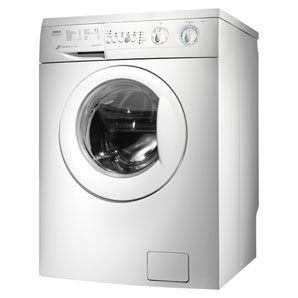Home Building Articles
Load up Your Washer for Energy Savings – Energy Star Appliances Save Money
November 04, 2009

Hardly anyone enjoys doing the laundry, but today the task is much easier than it
was a few decades ago. A job that once required a washboard and considerable elbow
grease now requires little more than the push of a button. These days, the hard
part is picking the right washing machine to buy.
Anyone who goes to an appliance store to look at washing machines encounters what
seem to be unlimited choices. A few years ago, the choices were simple: Do you want
white or off-white? Today, consumers must decide among top-loading, front-loading,
high-efficiency, water-saving, steaming, and wrinkle-remover models, just to name
only a few. Of course, as the number of options increases, so does the price.
One option that no one should overlook is an energy-efficient washing machine, which
can be identified most easily by the Energy Star label. Energy Star-rated washing
machines do cost slightly more than their less efficient counterparts, running from
$400 to $1500, depending upon what features the consumer desires. Obviously, the
more bells and whistles added, the greater the cost. Those bells and whistles do
not always mean more savings, however. For this reason, pay careful attention to
the yellow energy guide on a washing machine when making a purchase.
An energy-efficient washing machine can save the typical homeowner around $50 a
year, or $540 to $600 over the life of the appliance. Efficient washing machines
also could save more than 5,000 gallons of water a year. Careful shopping could
mean that the resulting savings will pay for the washing machine over its lifetime.
Energy Star qualification is usually restricted to front-loading and newer top-loading
models. These clothes washers use the latest technology to reduce energy and water
consumption substantially, compared to nonqualified models.
Front-loading clothes washers use a horizontal or tumble-axis basket to lift and
drop clothing into the water, instead of rubbing clothes around a central agitator
in a full tub. These units use less energy than conventional clothes washers by
reducing the amount of hot water needed to clean clothes. A clothes washer consumes
the most energy when it heats the water. Front-loading models also squeeze more
water out of clothes by using spin speeds that are two to three times faster than
conventional washers, thereby reducing both drying time and energy use.
Energy Star-qualified top-loading models typically use spray valves to rinse clothes,
rather than a new tub of water. The spray-rinse cycle consists of repeated high-pressure
rinses to remove soap residue. This method not only reduces the energy required
for water heating, but typically saves an average of 15 gallons of water per wash,
compared with conventional clothes washers.
Qualified top-loading models also feature sensors that monitor incoming water temperature,
which is then adjusted to maintain an optimal setting. This temperature keeps the
water hot enough to dissolve the detergent and provide high-performance cleaning,
but cool enough to save energy and minimize hot water damage to fabrics. This technology
results in less hot water consumption. One limitation of efficient top-loading washers
is that many models do not offer a high-temperature standard wash option.
Hardly anyone decides to retire a working clothes washer. Consumers typically start
looking for a replacement only after their current one fails. Price and features
generally are the two criteria considered for the new purchase. If you remember
to look for the Energy Star logo and shop at a store with knowledgeable staff, you
should be able to leave the store knowing that, over time, your new energy-efficient
washing machine will pay for itself.
*Source: Brian Sloboda – Texas Co-op Power Magazine November 2009